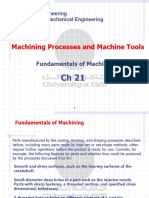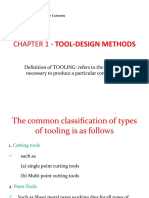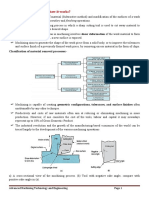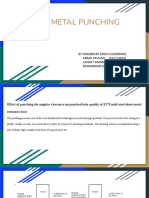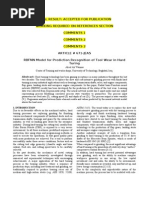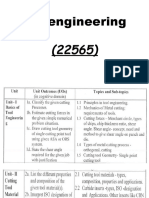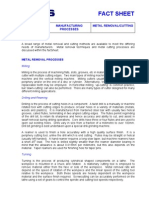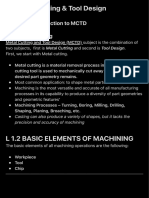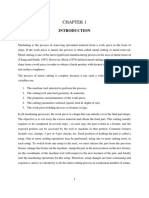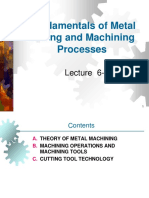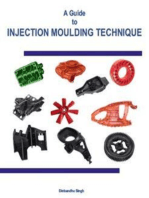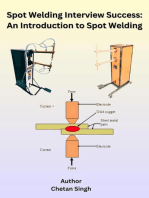Manufacturing Process - Module4.0
Uploaded by
Fiza KamaManufacturing Process - Module4.0
Uploaded by
Fiza KamaMANUFACTURING PROCESS
4.0 MATERIAL REMOVAL PROCESSES
INTRODUCTION
Machining is a manufacturing process in which a cutting tool is used to remove excess material from a workpart so that the remaining material is the desired part shape. The predominant cutting action involves shear deformation of the work material to form a chip. As the chip is removed, a new surface is exposed. Machining operations are considered to be the most versatile manufacturing techniques for the production of highly accurate part geometries. They can be utilized for the fabrication of one-of-a-kind products as well as for mass production. Machining operations can be classified according to the geometry of the objects profile ; rotational versus prismatic, as well as to the sizes of the object features. External and internal rotational object profiles can be achieved through turning and boring operations, respectively, carried out on lathes and/or boring machines. Prismatic profiles can be fabricated through milling operations carried out on a variety of milling machines.
LEARNING OBJECTIVES
At the end of this course the student will be able to: Outline the factors that influence a cutting process Describe the different types of chip formation State the types and functions of cutting fluids in machining State the various tool materials Explain several types of machining process
LEARNING OUTCOMES
At the end of this course the student has the ability to: Explain the basic theory of machining process, cutting fluids and cutting tools. Identify suitable machining process for a specific part features
BKT
DCP4062
MANUFACTURING PROCESS
4.1
INTRODUCTION
Final products are often obtained by machining shapes such as bar stock or plate to size. It is important that metal cutting principles are used in turning, planning, milling, and drilling operations as well as other processes performed by machine tools. Parts are produced by removing metal in the form of small chips. The cutting tool that removes these chips is the focus of many important principles.
4.2
METAL CUTTING THEORY
The simplest form of cutting tool is the single-point tool such as that found in a lathe cutoff operation or planner or shaper work. Multiple-point cutting tools are made of two or more single-point tools arranged together as a unit. The milling cutter and broaching tools are examples of multiple-point cutters. But the discussion in this section deals mostly with orthogonal tools in which the cutting edge is perpendicular to the direction of the cut and there is no lateral flow of metal. Nor is there curvature in these idealized forms, and all parts of the chip have the same velocity. In analyzing the cutting process it is assumed that the chip is severed from the workpiece by a shearing action across the plane as shown in the figure below, although other theories exists on chip formation. Because the deformed chip is in compression against the face of the tool, a frictional force is developed. The work of making the chip must overcome both the shearing force and the frictional force.
BKT
DCP4062
MANUFACTURING PROCESS
Orthogonal cutting tool model In the orthogonal cutting model the tool can be considered stationary and the workpiece moving. An opposite motion pattern does not change the concept. The state of stress before and after the shear plane is a complicated plastic flow of metal. The shear plane is determined by the rake angle of the tool and by the friction between the chip and the tool face.
Factors influencing cutting process Table above outlines the factors that influence a cutting process. The major independent variables in the cutting processes are as follows: Tool material, coatings and tool conditions Tool shape, surface finish and sharpness Workpiece material, condition, and temperature Cutting parameters, such as speed, feed and depth of cut Cutting fluids The characteristics of the machine tool, such as its stiffness and damping Workholder and fixturing
Dependent variables those that are influenced by changes in the independent variables are the following: Type of chip produced Force and energy dissipated in the cutting process Temperature rise in the workpiece, the chip, and the tool
BKT
DCP4062
MANUFACTURING PROCESS
Wear and failure of the tool Surface finish produced on the workpiece after machining
When unacceptable conditions result from machining operations, the manufacturing engineer must ask questions to determine the cause of the problem. The knowledge of mechanics of chip formation; chip types; force and power requirements; temperature rise caused by the cutting action; tool life; surface finish; and machinability will plan efficient and economical machining operations and can select the proper equipment and tooling.
4.3
CHIP FORMATION
Tool chips have been classified into three types as shown in figure below:
Basic chip types A discontinuous, B Continuous, C Continuous with build up edge.
Type 1, Figure a, name as discontinuous or segmental chip, and represent a condition in which the metal a head of the cutting tool is fractured into fairly small pieces. This type of chip is obtained in machining most brittle materials such as cast iron and bronze. As the chips are produced the cutting edge smooth over the irregularities and a fairly good finish is obtained. Tool life is reasonably good, and failure usually occurs as a result of abrading action on the contact surface of the tool. Discontinuous chips can also be formed on some ductile materials if the coefficient of friction is high. However, such chips on ductile materials are an indication of poor cutting conditions. An ideal type of chip from the standpoint of tool life and finish is the simple continuous chip Type 2 chip (Figure b), which is obtained in cutting ductile materials having a low coefficient of friction. In this case the metal is continuously deformed and slides up the face of the tool
BKT
DCP4062
MANUFACTURING PROCESS
without being fractured. Chips of this type are obtained at high cutting speeds are common when cutting is done with carbide tools. Because of their simplicity they can be analyzed easily from the standpoint of the forces involved. Continuous chips come off the bar stock as string from a ball and can be troublesome to handle and sometimes dangerous.
The Type 3 chip, Figure c, is characteristics of those machined from ductile materials that have a fairly high coefficient of friction. As the tools starts the cut, some of the materials, because of the high friction coefficient, builds up ahead of the cutting edge. Some of the workpiece may even weld onto the tool point, and thus known as a built-up edge or BUE. As the cutting proceeds, the chips flow over this edge and up along the face of the tool. Periodically a small amount of this BUE separates and leaves with the chip or is embedded in the turned surface. Because of this action, the surface smoothness is not as good as with the type 2 chip. The BUE remains fairly constant during cutting and has the effect of slightly altering the rake angle. However, as the cutting speed is increased, the size of the BUE decreases and the surface finish is improved. This phenomenon is also decreased by either reducing the chip thickness or increasing the rake angle, but many on the ductile material it cannot be eliminated entirely. Some investigators report that 97% of the work that goes into cutting is dissipated in the form of heat. Figure below shows the three zones in which the heat is generated. As the shear angle is increased, the percentage heat generated in the shear plane A will decrease because the plastic flow of the metal will take place over a shorter distance. The shear angle can be increased by applying a coolant and reducing the friction between the chip and the tool as by properly grinding the tool. Of the cutting variables, cutting speed has the most effect on temperature. To increase the rate of metal removal, an increase in feed is much to be preferred over an increase in speed.
BKT
DCP4062
MANUFACTURING PROCESS
Approximate sources of heat in three zones. A-Shear plane, B-Friction plane, C-Surface plane.
4.4
CUTTING FLUIDS
Cutting fluids are essential in most metal cutting operations. During a machining process, considerable heat and friction are created by the plastic deformation of metal occurring in the shear zone when the chip slides along the chip-tool interface. This heat and friction cause metal to adhere to the cutting tools edge, causing the tool to break down; the result is a poor finish and inaccurate work. Cutting fluids are used extensively in machining to achieve the following results: Reduce friction and wear, thus improving tool life and surface finish Reduce forces and energy consumption Cool the cutting zone, thus reducing workpiece temperature and thermal distortion Protect the machined surface from environmental corrosion
A cutting fluid basically may be a coolant or a lubricant. Its effectiveness in cutting operations depends on a number of factors, such as the method of application, temperature, cutting speed and type of machining operation. Four general types of cutting fluids are commonly used in machining operations: 1. Oils 2. Emulsions 3. Semisynthetics 4. Synthetics
BKT
DCP4062
MANUFACTURING PROCESS
The sources of oils can be mineral (petroleum), animal, vegetable or fish. Oil may be compounded with any number of additives or with other oils: this process is used to change such properties as viscosity-temperature behavior and surface tension, heat resistance and boundary layer characteristics. An emulsion is a mixture of two immiscible liquids, usually of oil and water in various proportions along with additives. Milky in appearance, emulsions are also known as water soluble oils or water-base coolants. Synthetic solutions are chemical fluids that contain inorganic and other chemicals dissolved in water; they do not contain any mineral oils. Various chemical agents are added to a particular solution to impart different properties. Semisynthetic solutions are basically synthetic solutions to which small amounts of emulsifiable oils have been added.
4.5
CUTTING TOOL GEOMETRY
To understand the cutting action of a single-point tool as applied to a lathe, refer to the cutting tool figure below. The tool has been ground to a wedge shape, the included angle being called the lip or cutting angle. The side relief angle between the side of the tool and the work is preventing the tool from rubbing. The angle is small, usually 6 to 8 for most materials. The side rake angle varies with the lip angle, which in turn depends on the type of material being machined. If the cutting tool is supported in a horizontal position, the back rake angle is obtained by grinding. End clearance is necessary to prevent a rubbing action on the flank of the tool.
Nomenclature for a right hand cutting tool
BKT
DCP4062
MANUFACTURING PROCESS
In grinding tools it should be noted that the lip of cutting angle varies with the kind of material being cut. The cutting angle must be keen enough to cut well with minimum of power consumption, yet the edge must be sufficiently strong to withstand the tool forces involved and to carry away the heat generated. A compromise is necessary. In general it is based on the hardness of the workpiece. Hard materials require a cutting edge of great strength with a capacity for carrying away heat. Soft materials (for example wood) permit the use of smaller cutting angles around 22, for soft and ductile material (copper and aluminium) require larger angles ranging up to 47 whereas brittle material require still larger angles. In addition to the solid single-point tool, a carbide tip may be brazed on or inserted in a tool holder.
Exploded view of a tool with disposable, triangular, carbide cutting point insert
BKT
DCP4062
MANUFACTURING PROCESS
Tools angles and cutting speeds for High Speed tools
4.6
CUTTING TOOL MATERIALS
The best material to use for certain job is the one that will produce the machined part at lower cost. Desirable properties for any tool material include the ability to resist softening at high temperature, a low coefficient of friction, good abrasive resisting qualities, and sufficient toughness to resist fracture.
High carbon steel: Carbon steel were used for all cutting tools, where their carbon content ranging from 0.80% to 1.2%. These steels have good hardening ability and with proper heat treatment, attain as great hardness as any high-speed alloys. Because these tools lose hardness at temperature 300C they are not suitable for high cutting speed and heavyduty work.
High speed steel: Known as HSS, it high in alloy content, excellent hardenability, and will retain a good cutting edge to temperatures of around 650C. The ability of tool to resist softening at high temperatures is known as red hardness and is a most desirable quality. Normally it contain of 18% tungsten, 5.5% chromium to steel as the principal alloying elements.
BKT
DCP4062
MANUFACTURING PROCESS
Carbide
Carbide cutting tool inserts are made only by the powder metallurgy technique. The metal powders of tungsten carbide (94%) and cobalt (6%) are pressed to shape, semi sintered to facilitate handling and forming to final shape, sintered in a hydrogen atmosphere furnace at 1550C and finished by grinding operation. Carbide tools permit cutting speeds more higher but at such speeds that a much smaller feed must be used. From an economic point of view, carbide tools should always be used if possible. Diamond :
Diamonds used as single-point tools for light cuts and high speeds must be rigidly supported because of their high hardness and brittleness. They are used either for hard materials difficult to cut with other tool materials or for light, high speed cuts on softer materials where accuracy and surface finished are important. It is commonly used for machining plastics, hard rubber or aluminium where the cutting speeds is high.
4.7
MACHINING PROCESSES
All machining processes remove material to form shapes. As metals are still the most widely used materials in manufacturing, machining processes are usually used for metals. However, machining can also be used to shape plastics and other materials which are becoming more widespread. Basically all the different forms of machining involve removing material from a component using a rotating cutter. The differences between the various types arise from the relative motion between cutting tool and workpiece and the type of cutting tool used. Typically machining will be done using a machine tool. This tool holds the workpiece and the rotating cutting tool and allows relative movement between the two. Usually machine tools are dedicated to one type of machining operation, although some more flexible tools allow more than one type of machining to be performed. The machine tool can either be under manual or automatic (Computer Numeric Control - CNC) control. The cutting speed of the tool is usually dictated by the type of material being machined, in general the harder the material, the slower the machining time. Machining speed can be increased by increasing the rotational speed of the cutter; however this will be at the expense of the tool life.
BKT
10
DCP4062
MANUFACTURING PROCESS
In order to dissipate the heat generated between the workpiece and the cutting tool, cutting fluids are sprayed onto the tool. The cutting fluid also acts to remove cut material away from the cutting region and lubricates the tool - workpiece interface but may require that the component is cleaned afterwards. Advantages
Machining processes allow high precision components to be rapidly produced.
Disadvantages
Machining processes are not suitable for removing large amounts of material. There can be a large amount of wastage.
4.7.1
LATHE AND LATHE OPERATIONS
Lathes are generally considered to be the oldest machine tools. The most common lathe was originally called an engine lathe because it was powered with overhead pulleys and belts from nearby engines. Today these lathes are equipped with individual electric motors. The lathe is one of the most versatile machine tools used in industry. The work is held and rotated on its axis while the cutting tool is advanced along the lines of a desired cut. With suitable attachments, the lathe may be used for turning, tapering, form turning, screw cutting, facing, drilling, boring, knurling, grooving and polishing operations.
Turning In a typical turning operation, the workpiece is clamped by one of the workholding. Turning process is to produce straight, conical, curved, or grooved workpieces such as shafts, spindles and pins.
Boring The boring operation on a lathe is similar to turning. Boring is performed inside hollow workpieces or in a hole made previously by drilling or other means. Out of shape holes can be straightened by boring. The workpiece is held in a chuck or in some other suitable workholding device.
BKT
11
DCP4062
MANUFACTURING PROCESS
Drilling Drilling can be performed on a lathe by mounting the drill bit in a drill chuck into the tailstock quill (a tubular shaft). The workpiece is placed in a workholder on the headstock, and the quill is advanced by rotating the hand wheel. Holes drilled in this manner may not be concentric because of the tendency for the drill to drift radially. The concentricity of the hole is improved by subsequently boring the drilled hole. Drilled holes may be reamed on lathes in a manner similar to drilling, thus improving hole tolerances.
Form Turning Form turning produces a concave or convex form of internal or external surfaces of a workpiece. Form tools are used to produce various shapes on round workpieces by turning. The tool moves radially inward to machine the part. Machining by form cutting is not suitable for deep and narrow grooves or sharp corners because they may cause vibration and result in poor surface finish.
Knurling Knurling is a process of impressing a diamond-shaped or straight-line pattern into the surface of the workpiece to improve its appearance or to provide better gripping surface. Straight knurling is often used to increase the workpiece diameter when a press fit is required. Knurling is performed on a lathe with hardened rolls in which the surface of the rolls is replica of the profile to be generated. The rolls are pressed radially against the rotating workpiece, while the tool moves axially along the part.
Grooving Grooving, commonly called recessing, undercutting or necking, is often done at the end of a thread to permit full travel of the nut up to a shoulder, or at the edge of a shoulder to ensure a proper fit of mating parts. Grooves are generally square, round or V-shaped.
Threading Thread cutting on a lathe is a process that produces a helical ridge of uniform section on a workpiece. This is performed by taking successive cuts with a
BKT
12
DCP4062
MANUFACTURING PROCESS
threading tool bit of the same shape as the thread form required. Work to be threaded may be held between centers or in a chuck.
4.7.2 MILLING OPERATIONS
Milling includes a number of highly versatile machining operations capable of producing a variety of configurations with the use of a milling cutter, a multitooth tool that produces a number of chips in one revolution. Used for general purpose milling operations, column and knee type milling machines are the most common milling machines. The spindle to which the milling cutter is may be horizontal for slab milling or vertical for face and end milling and end milling, boring and drilling operations.
Horizontal Milling Machine
BKT
13
DCP4062
MANUFACTURING PROCESS
Vertical Milling Machine
4.7.2.1 CLASSIFICATION OF MILLING
Peripheral Milling In peripheral (or slab) milling, the milled surface is generated by teeth located on the periphery of the cutter body. The axis of cutter rotation is generally in a plane parallel to the workpiece surface to be machined. Face Milling In face milling, the cutter is mounted on a spindle having an axis of rotation perpendicular to the workpiece surface. The milled surface results from the action of cutting edges located on the periphery and face of the cutter. End Milling The cutter in end milling generally rotates on an axis vertical to the workpiece. It can be tilted to machine tapered surfaces. Cutting teeth are located on both the end face of the cutter and the periphery of the cutter body.
BKT
14
DCP4062
MANUFACTURING PROCESS
Some of the basic type of milling cutters and milling operations; (a) slab milling (b) face milling (c) end milling
4.7.2.2 METHODS OF MILLING
Up Milling Up milling is also referred to as conventional milling. The direction of the cutter rotation opposes the feed motion. For example, if the cutter rotates clockwise, the workpiece is fed to the right in up milling.
Conventional milling Down Milling Down milling is also referred to as climb milling. The direction of cutter rotation is same as the feed motion. For example, if the cutter rotates counterclockwise, the workpiece is fed to the right in down milling.
BKT
15
DCP4062
MANUFACTURING PROCESS
Climb milling
4.7.3 PLANING
Planing is a material removal process in which the workpiece reciprocates against a stationary single-point cutting tool producing a plane surface. Planing is relatively simple cutting operation by which flat surfaces, as well as various cross-sections with grooves and notches are produced along the length of the workpiece. Planning is usually done on large workpiece.
4.7.4 SHAPING
Shaping is a material removal process in which a single-point cutting tool reciprocates across the face of a stationary workpiece to produce a plane or sculpted surface. Shaping is used to machine parts; it is much like planning, except that the parts are smaller. Cutting by shaping is basically the same as by planning. In a horizontal shaper, the tool travels along a straight path and the workpiece is stationary. The cutting tool is attached to the tool head, which is mounted on the ram. The ram has a reciprocating motion and in most machines cutting is done during the forward movement of the ram. Vertical shapers (slotter) are used to machine notches, keyways and dies.
BKT
16
DCP4062
MANUFACTURING PROCESS
4.7.5 BROACHING
The broaching operation is similar to shaping with multiple teeth and is used to machine internal and external surfaces, such as hole of circular, square or irregular section, keyways and the teeth of internal gears. A broach is a long multitooth cutting tool; the total depth of material removed in one stroke is the sum of the depths of cut of each tooth of the broach. A large broach can remove material as deep as 38mm in one stroke. Broaching is an important production process and can produce parts with very good surface finish and dimensional accuracy. It competes favorably with other processes such as boring, milling, shaping and reaming to produce similar shapes. Although broaches can be expensive, the cost is justified with highquantity production runs.
BKT
17
DCP4062
MANUFACTURING PROCESS
(a) Broaching tooth nomenclature and terminology (b) Illustration of how a chip fills the gullet during a broaching operation
BKT
18
DCP4062
You might also like
- Machine Tools and Digital Manufacturing (MTDM) : Machining ProcessNo ratings yetMachine Tools and Digital Manufacturing (MTDM) : Machining Process90 pages
- 1 - Chapter 6 - 1 - 1 Material Removal Process - Introduction 21-1No ratings yet1 - Chapter 6 - 1 - 1 Material Removal Process - Introduction 21-134 pages
- Manufacturing Technology-Fundamentals of MachiningNo ratings yetManufacturing Technology-Fundamentals of Machining33 pages
- 1 Introduction Machining & Machinability RNo ratings yet1 Introduction Machining & Machinability R16 pages
- Lecture 2 - 4 - Fundametals of MachiningNo ratings yetLecture 2 - 4 - Fundametals of Machining58 pages
- Production Engineering: (Fundamental of Metal Cutting)No ratings yetProduction Engineering: (Fundamental of Metal Cutting)12 pages
- Effect Modified Rake Angle Endmill Two Flute in AISI 1045 Machines Using CNC Milling PDFNo ratings yetEffect Modified Rake Angle Endmill Two Flute in AISI 1045 Machines Using CNC Milling PDF10 pages
- Modeling and Simulation of Turning OperationNo ratings yetModeling and Simulation of Turning Operation8 pages
- Fundamentals of Metal Cutting and Machining Processes: Lecture 6-7No ratings yetFundamentals of Metal Cutting and Machining Processes: Lecture 6-7150 pages
- Spot Welding Interview Success: An Introduction to Spot WeldingFrom EverandSpot Welding Interview Success: An Introduction to Spot WeldingNo ratings yet
- Welding Terminology: A Guide to MIG, TIG, Stick, Gas, and Spot Welding TermsFrom EverandWelding Terminology: A Guide to MIG, TIG, Stick, Gas, and Spot Welding TermsNo ratings yet
- Prompting Science and Engineering Students in Practical TrigonometryFrom EverandPrompting Science and Engineering Students in Practical TrigonometryNo ratings yet
- Experiment No. 9: To Perform Parting Operation On LatheNo ratings yetExperiment No. 9: To Perform Parting Operation On Lathe3 pages
- Single Point Cutting Tool: Definition, Types, Geometry, Nomenclature, Angle, PDFNo ratings yetSingle Point Cutting Tool: Definition, Types, Geometry, Nomenclature, Angle, PDF6 pages
- Suction Hose Couplings For Fire Fighting Purposes - SpecificationNo ratings yetSuction Hose Couplings For Fire Fighting Purposes - Specification9 pages
- Tools For Minifix GV Joint Connectors: Precision Drilling JigNo ratings yetTools For Minifix GV Joint Connectors: Precision Drilling Jig1 page
- Success Built On Experience: Ongoing Development of Radial Forging TechnologyNo ratings yetSuccess Built On Experience: Ongoing Development of Radial Forging Technology2 pages
- Workshop Technology Lab Report (20140507)No ratings yetWorkshop Technology Lab Report (20140507)2 pages
- Product Catalogue: Your Specialist in Flow DrillingNo ratings yetProduct Catalogue: Your Specialist in Flow Drilling64 pages
- G6 Q1W2 DLL TLE - INDUSTRIAL ARTS (MELCs)No ratings yetG6 Q1W2 DLL TLE - INDUSTRIAL ARTS (MELCs)16 pages
- Safety, Ergonomics, and Shop Layout: by Dan Nauman and The Educational Programs CommitteeNo ratings yetSafety, Ergonomics, and Shop Layout: by Dan Nauman and The Educational Programs Committee4 pages
- Machine Tools and Digital Manufacturing (MTDM) : Machining ProcessMachine Tools and Digital Manufacturing (MTDM) : Machining Process
- Weld Like a Pro: Beginning to Advanced TechniquesFrom EverandWeld Like a Pro: Beginning to Advanced Techniques
- 1 - Chapter 6 - 1 - 1 Material Removal Process - Introduction 21-11 - Chapter 6 - 1 - 1 Material Removal Process - Introduction 21-1
- Manufacturing Technology-Fundamentals of MachiningManufacturing Technology-Fundamentals of Machining
- Production Engineering: (Fundamental of Metal Cutting)Production Engineering: (Fundamental of Metal Cutting)
- Effect Modified Rake Angle Endmill Two Flute in AISI 1045 Machines Using CNC Milling PDFEffect Modified Rake Angle Endmill Two Flute in AISI 1045 Machines Using CNC Milling PDF
- Fundamentals of Metal Cutting and Machining Processes: Lecture 6-7Fundamentals of Metal Cutting and Machining Processes: Lecture 6-7
- Spot Welding Interview Success: An Introduction to Spot WeldingFrom EverandSpot Welding Interview Success: An Introduction to Spot Welding
- Tools and Function Lists: Engineering Tools ManualFrom EverandTools and Function Lists: Engineering Tools Manual
- Welding Terminology: A Guide to MIG, TIG, Stick, Gas, and Spot Welding TermsFrom EverandWelding Terminology: A Guide to MIG, TIG, Stick, Gas, and Spot Welding Terms
- Prompting Science and Engineering Students in Practical TrigonometryFrom EverandPrompting Science and Engineering Students in Practical Trigonometry
- Experiment No. 9: To Perform Parting Operation On LatheExperiment No. 9: To Perform Parting Operation On Lathe
- Single Point Cutting Tool: Definition, Types, Geometry, Nomenclature, Angle, PDFSingle Point Cutting Tool: Definition, Types, Geometry, Nomenclature, Angle, PDF
- Suction Hose Couplings For Fire Fighting Purposes - SpecificationSuction Hose Couplings For Fire Fighting Purposes - Specification
- Tools For Minifix GV Joint Connectors: Precision Drilling JigTools For Minifix GV Joint Connectors: Precision Drilling Jig
- Success Built On Experience: Ongoing Development of Radial Forging TechnologySuccess Built On Experience: Ongoing Development of Radial Forging Technology
- Product Catalogue: Your Specialist in Flow DrillingProduct Catalogue: Your Specialist in Flow Drilling
- Safety, Ergonomics, and Shop Layout: by Dan Nauman and The Educational Programs CommitteeSafety, Ergonomics, and Shop Layout: by Dan Nauman and The Educational Programs Committee





